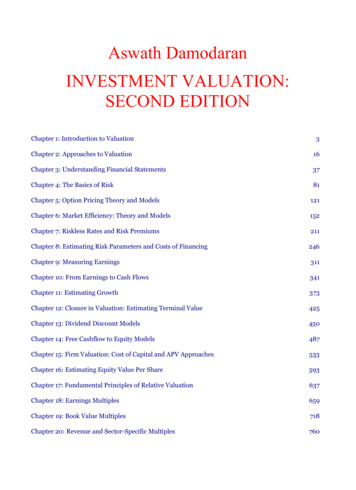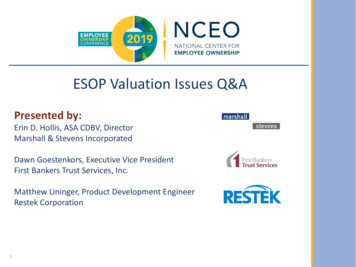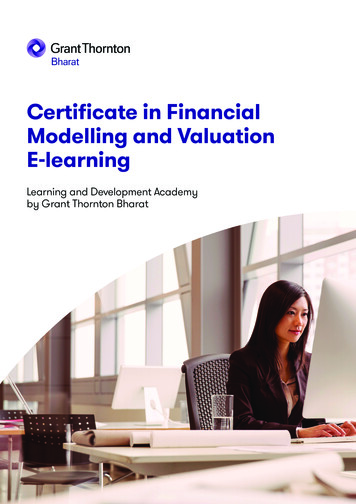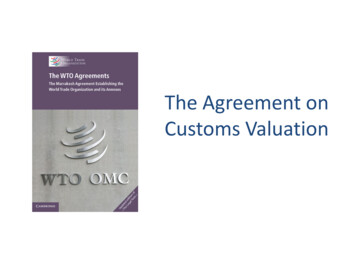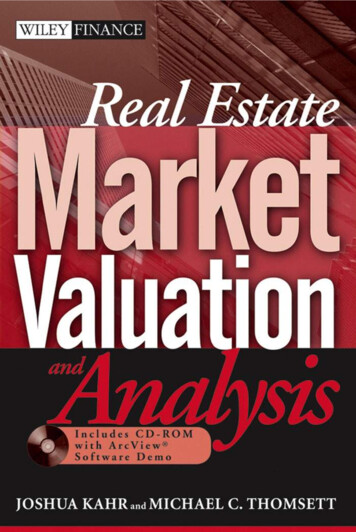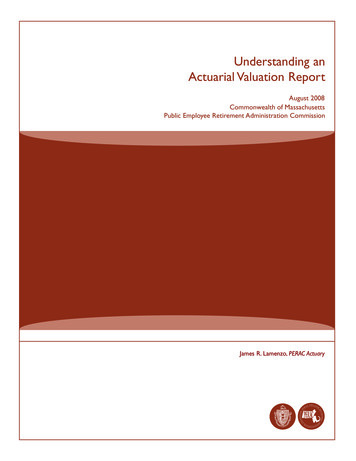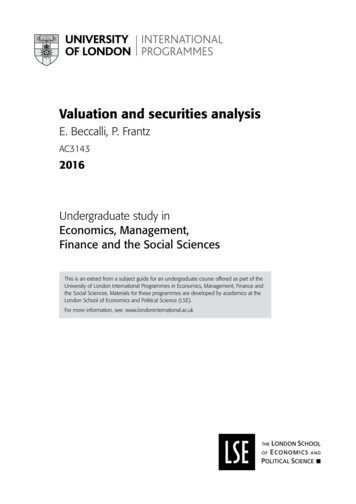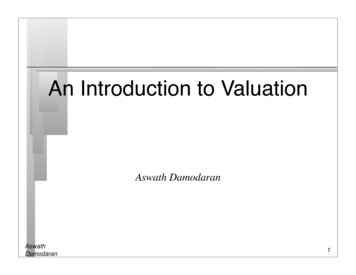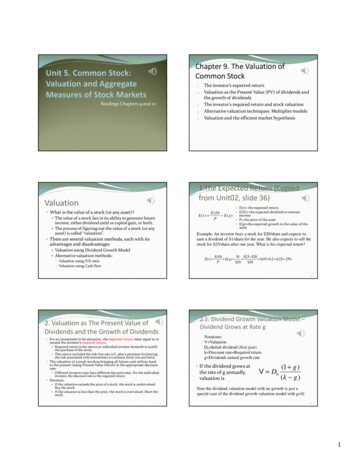
Transcription
Chapter 9. The Valuation ofCommon Stock1.The investor’s expected return2. Valuation as the Present Value (PV) of dividends andthe growth of dividendsReadings Chapters 9 and 103. The investor’s required return and stock valuation4. Alternative valuation techniques: Multiplier models5. Valuation and the efficient market hypothesis1.The Expected Return (Copiedfrom Unit02, slide 36)Valuation E(r) the expected return What is the value of a stock (or any asset)? The value of a stock lies in its ability to generate futureincome, either dividend yield or capital gain, or both. The process of figuring out the value of a stock (or anyasset) is called “valuation”. There are several valuation methods, each with its E(D) the expected dividend or interestE ( D)incomeE (r ) E(g)P P the price of the asset E(g) the expected growth in the value of theassetExample: An investor buys a stock for 20/share and expects toearn a dividend of 1/share for the year. He also expects to sell thestock for 25/share after one year. What is his expected return?advantages and disadvantages Valuation using Dividend Growth Model Alternative valuation methods: Valuation using P/E ratio Valuation using Cash flowE(r) E(D) 1 25 20 E(g) 0.05 0.2 0.25 25%P 20 20342.1. Dividend Growth Valuation Model –Dividend Grows at Rate g2. Valuation as The Present Value ofDividends and the Growth of DividendsNotations:V ValuationD0 Initial dividend (first year)k Discount rate Required returng Dividends annual growth rate For an investment to be attractive, the expected return must equal to orexceed the investor’s required return. Required return is the return an individual investor demands to justifythe purchase of the stock. This return included the risk-free rate (rf), plus a premium for bearingthe risk associated with investments in common stock (rm and beta). The valuation of a stock involves bringing all future cash inflows backto the present (using Present Value Factor) at the appropriate discountrate. Different investors may have different discount rates. For the individualinvestor, the discount rate is the required return. Decision: If the valuation exceeds the price of a stock, the stock is undervalued.Buy the stock. If the valuation is less than the price, the stock is overvalued. Short thestock. If the dividend grows atthe rate of g annually,valuation isV D0(1 g )(k g )Note the dividend valuation model with no growth is just aspecial case of the dividend growth valuation model with g 0)561
2.2. Examples1. Given the following data, what is the value of the stock?2. Now suppose this stock is traded in the market for 18a share. Should this investor (with a 12% requiredreturn) buy this stock? Answer: No. Because the stock’s value is only 17.67,less than the market price of 18. Thus this stock isovervalued. Required return (discount rate) k 12% Present dividend D0 1 Dividend growth rate g 6% Answer: This is a valuation case using dividend growthvaluation model.V D0 (1 g ) 1 * (1 6%) 17.67(k g )(12% 6%)72.3. How to Valuate MoreComplicated Dividend Patterns?3. Given the following data, what is the value of the stock? Required return k 12% If the dividend patterns are more complicated, such as Present dividend D0 1a combination of super growth for several years andslow growth later on, one can still use the dividendgrowth model. The only difference is that the equationsetup is a bit more complicated. Dividend growth rate g 0% (no growth) Answer: This is a valuation case when there is nodividend growth.V 8D0 (1 g ) D0 1 8.33(k g )k12%If the market price of this stock is over 8.33, don’t buy. If it’sunder 8.33, buy.92.4. Some Generalizations from theDividend Growth Model103. Required Return and Stock Valuation The larger the initial dividend, the higher the Note that in the previous examples a required returnvaluation. The higher the dividend growth rate, the higher thevaluation. The lower the required return (discount rate), thehigher the valuation.was just given to you. But how is the required returndetermined? Review the Capital Assets Pricing Model (CAPM) andthe Security Market Line of Unit02.11122
Unit02: Beta Coefficients and The SecurityMarket Line3.1. Required Return The return on a stockdepends on rs is the required return. In the context of stock valuation, this rs is typically The risk free rate (rf ) The return on the marketdenoted as k(rM) K rs rf (rM - rf )β, where rf the risk free rate (i.e.Treasure Bill rate) rM the return on the market β the stock's beta The stock's beta (β) The return on a stock is rs rf (rM - rf )β E.g. If rM 6%, rf 3%, stockABC β is 1.2 then return onstock ABC is rs 3% (6% - 3%)x1.2 6.6%133.2. An Example of Computing RequiredReturn143.3. An Example of Valuation IncorporatingRisk-Adjusted Required Return The annual risk-free rate of return is 4%. The Firm XYZ’s current dividend is 2.00 (D0), which isoverall market rate of return is 12%. ABC stockhas a Beta of 1.4. What is the required return forABC stock, adjusting for its risk? Answer: The required return k is:expected to grow annually at 5% (g). The risk free rate is3.5% (rf ), and the market return is expected to be at10% (rM). If the Firm XYZ stock has a Beta of 1.2, whatshould be the value of XYZ’s stock? Answer: Step 1. Compute required returnk rf (rM - rf )β 4% (12% - 4%) *1.4 15.2% k 3.5% (10%-3.5%)*1.2 3.5% 7.8% 11.3% Step 2. Compute valuation V using Dividend Growth Model:V D0 (1 g ) 2.00 * (1 5%) 33.33(k g )(11.3% 5%)15163.5. Advantages and Shortcomingsof the Dividend Growth Model3.4. Beta and Valuation Advantages If Beta is larger, the risk is higher. Thus the required Theoretically sound Practically doable with assumptions – can provide usefulreturn is higher to compensate for that risk. Assumedividend and dividend growth rate are the same, thestock with a higher beta has a lower value.information beyond hunchs and intuitions. Shortcomings If a stock does not pay a dividend right now, as in this case of manygrowth stocks, valuation can be difficult. Beta can be different for the same stock, depending on data used tocompute Beta. The risk-free rate is not an easy determination. Long-term TreasuryBill (TB) rate can be different from short-term TB rate Similar problems exist on rate of return of the market and dividendgrowth rate. Basically many assumptions need to be made in orderfor the Dividend Growth Model to work well.17183
4. Alternative ValuationTechniques: Multiplier Models4.1. Valuation Using P/E Ratio There are some alternative valuation techniques analysts P/E ratio is the price to earning ratio of a stock. E.g., If the current stock price is 50, and earnings peryear on the stock is 20, then the P/E 50/20 2.5 Stock valuation using P/E: P (m)(EPS)use to identify stocks for purchase. These techniquesinclude P/E ratio – Price Earning ratio Cash flow P/S ratio – Price Sales ratio PEG ratio – P/E divided by the growth rate of Earnings Adjusted PEG m is the “appropriate P/E ratio”.EPS is earnings per share E is P/E ratio. E.g., If the financial analysts believe the appropriate P/E Price/Book ratioratio (m) for a particular stock should be, say 5, and theearning per share (EPS) for this stock is 3.5, then thevalue of this stock is P m*EPS 5* 3.5 17.5 Return on equity to Price/Book ratio Profit margin to Price/Book ratio19204.2. Valuation Using Cash FlowWeakness in the Use of P/E Ratio Question of the appropriate multiplier Cash flow is the balance of the amounts of cash What is an appropriate P/E (m)?being received and paid by a business. Today most stocks trade between 15-25 P/E range. In the Dot-com The valuation process of using cash flow isbubble the average P/E had risen to 32. The collapse in earningscaused P/E to rise to 46.5 in 2001. A possible solution is to use current industrial average P/E ratio asthe appropriate P/E (m).essentially the same as is used with P/E ratio,except cash flow is substituted for earnings. Again, the determination of future cash flow andthe determination of appropriate multiplier are atthe discretion of the analyst. Differences in estimated earnings A particular year’s earnings may contain special items that do notoccur every year. Adjustments should be made for such events. Historical earnings may not predict future earnings.214.3. Price to Book Ratio (P/B) andPrice to Sales Ratio (P/S)224.4. The PEG Ratio Standardizes the P/E ratio for growth P/B ratio is the ratio of stock price to the per-share bookvalue (B).P Book value is an accounting term denoting the company’s totalPEG assets less its total liabilities. Per share book value is “Book value”/ “Number of outstandingshares” P/S ratio is the ratio of stock price to per share sales. Conceptually using P/B ratio or P/S ratio for valuation ofEEarnings growth rate Low PEG ratios (below 1.0) suggestundervaluation.stocks is the same as using P/E ratio. Same weaknesses apply E.g., If a stock’s P/E is 15, and the per-shareearning growth rate is 10%, PEG 15/10 1.523244
4.5. Additional RatiosAdjusted PEG Ratio Adjusted PEG ratio takes both dividends andgrowth into consideration.Return on equityPrice/BookPEGrowth rate Dividend yield E.g., If in the previous example dividend yield is2% on top of the 10% earning growth rate, thenthe adjusted PEG 15/(10 2) 1.25 Low values of adjusted PEG is better than highvalues.PEG Adj. Profit marginPrice/Sale s- Return on equity is earningsdivided by a firm’s equity and is ameasure of performance.- The higher the better.-Profit margin is the ratio ofearnings to sales.-The higher the better.255. Valuation and the Efficient MarketHypothesis (EMH)An Example Stock valuation and selection is not a mechanical One can get stock technical information online. Yahoo Finance is agood place to go. Here is the information on Wal-Mart I found onYahoo Finance. http://finance.yahoo.com/q/ks?s WMT. The siteupdates numbers frequently so what you see may be different fromwhat I cite below. P/E ratio – there are two P/E ratios (Trailing P/E is 18.80 and ForwardP/E is 16.73). P/S ratio – P/S is 0.61 PEG ratio – PEG ratio (5 year expected) is 1.53. P/B ratio - P/B is 3.65 Return on equity to Price/Book ratio. 26process. These ratios can provide information, but they areby no means definitive. Depending on the data and method, analyticaltechniques may be manipulated to achieve prettymuch any preconceived results. The result is that few investors and securitiesanalysts consistently outperform the market on arisk-adjusted basis – consistent with the EfficientMarket Hypothesis (EMH)Return on equity is 20.75%Return on equity to P/B 20.75%/3.65 5.68% Profit margin to Price/Book ratio Profit margin is 3.38% Profit margin to P/B 3.38%/3.65 0.93%27Chapter 10. Investment Returns andAggregate Measures of Stock Markets1.2.3.4.5.Measures of stock performance: Averages andIndexesThe DowOther indexes of aggregate stock pricesRates of return on investments in common stocksReducing the impact of price fluctuations: Averaging281. Measures of Stock Performance:Averages and Indexes Many averages and indexes have been developed to tracksecurity price movements, such as the Dow Jones averagesand the S&P 500. The composition for these indexes differ. Dow Jones Industrial Average includes 30 companies. S&P 500 includes 500 companies The methods of calculation also differ: Price-weighted average Value-weighted average Equal-weighted average Geometric weighted average305
1.1. A Price-weighted Average1.2. A Value-weighted Average Weights the prices by the number of shares outstanding Continue with the previous example: Price of stock A 10 Price of stock B 20 Additional information is needed for value-weighted average: Number of shares outstanding of stocks A: 1,000,000 Number of shares outstanding of stocks B: 10,000,000 Total value of each stock needs to be calculated Total value of stock A 10*1,000,000 10,000,000 Total value of stock B 20*10,000,000 200,000,000 Weighted Average Price is total value divided by total shares Weighted average price 210,000,000/(1,000,000 10,000,000) 19.09 The S&P 500 stock index uses the value-weighted average method. Price of stock A 10 Price of stock B 20 Price-weighted average is( 10 20)/2 15 The Dow-Jones Industrial Average uses this method.311.3. An Equal-weighted Average This approach assumes equal dollar amount invested in321.4. A Geometric Average Instead of dividing, take the 1/n root. Example:each stock. Price of stock A 10 Continue with previous example Price of stock B 20 Price of stock A is 10 Price of stock B is 20. n 2 (two stocks) Assume one invests 100 in each stock Geometric average price of a share: (10)(20) (1/2) Share of A purchased 100/10 10 Share of B purchased 100/20 5 14.14 Average price of a share: 200/(10 5) 200/15 13.33 Note with this approach it does not matter whether you The Value-Line stock index uses the geometricassume 100 invested in each stock or 1 million invested ineach stock. The answer is the same.average method.331.5. Comparison of Prices over time:Graphical illustrations34Use of Different Scales to Illustrate StockPrice Movements Often historical trend of stock prices areillustrated using graphs. While the horizontal axis is always “Time (year,month, or day)”, the vertical axis can have differentscales so interpretation needs to be carefully done. Absolute price scale: Equal dollar amount change as thevertical axis. Relative price scale: Equal percentage change as thevertical axis.Dollar scale – each equal distanceon the vertical axis is a 5 increase35Percentage scale, each equal distanceon the vertical axis is a 100% increase.366
Use of Linear vs. Log Scale: Dow JonesIndustrial Average from 1928 to 2011Graphical Illustrations: Linear Scale vs. LogScale For Composite Indexes, often there are two ways:Linear scale and Log scale Presentation of data on a log scale can be helpful whenthe data cover a large range of values – the logarithmreduces this to a more manageable range. Next slide shows two Dow Jones Composite Indexgraphs: Linear scale and Log scale.The above graph is in linearscale. Because there are lots ofdata points, the trend in the earlyyears is difficult to see.The above graph is in log scale. Thetrend in the early years is much easierto see. However one needs to becareful when interpreting this graph.37382. Dow Jones Industrial AverageCommon Stock Market Indexes Perhaps the most well-known index is the Dow Jones IndustrialAverage. Created by Charles Dow in 1896. Of the original 12, only GE iscurrently still part of the index. In 1916, number of stock in the index increased to 20. Itincreased to 30 in 1928. Currently comprised of 30 largest and most widely held publiccompanies in the U.S. Price-weighted and scaled average. There are many stock market indexes, domestic andinternational. Yahoo Finance has a great list: Major world indices:http://finance.yahoo.com/intlindices?e americas Major U.S. indices:http://finance.yahoo.com/indices?e dow jones Scaled average means the divisor changes so that substitutions ofone firm for another has no impact on the average. For a good description of the history and some interestinganecdotes seehttp://en.wikipedia.org/wiki/Dow Jones Industrial Average39403. Additional Aggregate Measures of theStock Market Include:Annual Price of the Dow Jones IndustrialAverage 1928 to 2011: Log Scale Standard & Poor's 500 stock index: Contains the stocks of 500 large-cap corporations. http://en.wikipedia.org/wiki/S&P 500 When first published itstood at 40.94. The largest one day % gainwas 15.34% on 3/15/1933. The largest one day %drop since 1914 was 22.61%on “Black Monday” –10/19/1987. NYSE composite index http://en.wikipedia.org/wiki/NYSE Composite Value Line Stock average http://en.wikipedia.org/wiki/Value Line Composite Index Nasdaq composite index http://en.wikipedia.org/wiki/NASDAQ Dow Jones Wilshire 5000 index http://en.wikipedia.org/wiki/Wilshire 5000 Russell 1000, Russell 2000, Russell 3000 http://en.wikipedia.org/wiki/Russell Indexes S&P 400 MidCap http://en.wikipedia.org/wiki/S&P 400 S&P 600 SmallCap http://en.wikipedia.org/wiki/S%26P 600 S&P 1500 http://en.wikipedia.org/wiki/S&P 150041427
3.2. Aggregate Measures of the StockMarket Prices and Correlations3.1. Specialized Indexes The graph shows 5year trend in DowJones IndustrialAverage ( DJI),S&P ( GSPC), andNASDAC ( IXIC). One can see thatthe correlationsamong aggregatemeasures of theAmerican stockmarkets is high.4344Dow Jones Bond Average and Yields on Mergent’s(Moody’s) Aaa-Rated Bonds, 1978–20003.3. Bond Averages In addition to stock indexes, there are aggregate measuresof the bond market. Bond averages are expressed in yield instead of prices. Yield can be expressed in both dollars and percentagechanges. Bond Indexes: Can be categorized based on their broadcharacteristics, such as whether they are governmentbonds, corporate bonds, high-yield bonds, mortgagebacked securities, etc. They can also be classified based ontheir credit rating or maturity.Inverse relationship between bond price and yield. During the periodcovered in this graph, bond prices (Dow Jones Bond Average, blue line)was going down while yield ( gray line) was going up. An example: Dow Jones Corporate Bond Index http://www.djindexes.com/mdsidx/?event showCorpBond453.4. The Volatility Index (VIX) – the“fear” index46Historical Data on VIX (Linear Scale) The VIX is a measure of investors’ expectations aboutnear-term market volatility. The calculation of the VIX is based on the S&P 500index options and is expressed in percentages (optionsare explained in later units). Low values suggest low volatility (e.g. VIX 10) High values suggest high volatility (e.g. VIX 50)47488
3.5. Securities Prices and Inflation –Changes in Real Terms (Instead of Nominal) Sometimes one might be interested in measuringsecurities price performance in comparison to ageneral price index, such as the Consumer Price Index(CPI). When adjusted for CPI, stock performance is muchmore modest.This is a graph showing nominal NYSE index (blue line) and inflationadjusted NYSE index (red line). The key point is to look at the slope of theselines: the real price increases are a lot less than the nominal price increasesdue to inflation.49504.1.Holding Period Return (HPR)4. Rates of Return on Investments The percentage earned on an investment during a period of timeHPR P1 D 1P0 Just as there are many ways to compute an average,there are several ways to compute a return. Holding period return P0 is purchase price, P1 is sell price, D is dividend. Example: You bought a stock for 20. After a year the price rose to 25 but fell back to 22 at the end of the second year. The totaldividend payment for the two years was 2. What was the holdingperiod return? Answer: In this case the holding period is two years. For holding periodreturn only the beginning and ending prices matter, the middleprice ( 25 in this case) does not matter. Holding period return ( 22 2)/ 20-1 20% Major weakness of HPR Does not consider the length of time Dollar-weighted return (also called: internal rate ofreturn, true annualized rate of return) Time-weighted return (also called: average percentagereturn)51524.2. Dollar-Weighted Rate of Return (Also called “TrueAnnualized Return” or “ Internal Rate of Return”) Consider the previous example again. You bought a This measure takes compounding into consideration. It is the discount rate that equates the cost of anstock for 20. After a year the price rose to 25 but fellback to 22 at the end of the second year. Dividendswere 1 per year. What was the true annualized return? Answer:investment with the present value of cash flowsgenerated by the investment. See equation below. Solve for r. Computation can be very tedious. But if the dividendamount is the same every year, one can simplify thedividend part of the equation using Present ValueFactor Sum (PVFS, see Week 1 notes or FCS3450 notes)P0 20 D1DnP1 . (1 r )(1 r ) n (1 r ) n1122 ,(1 r ) (1 r ) 2 (1 r ) 2Solving for r using Excel by trying differentnumbers for r, r 9.76%Weaknesses of the internal rate of return:- Assumes cash flows are reinvested at that internal rate of return.53549
4.4. A Simplified Case: Returnwithout Dividends4.3. Time-Weighted Rate of Return –Simple Average and Geometric Average The time-weighted rate of return is to compute return for everyyear, and then take the average. Simple average is also called ‘average percentage return”. Geometric average is the true compound rate. Consider the previous example again. You bought a stock for 20.After a year the price rose to 25 but fell back to 22 at the end ofthe second year. Dividends were 1 per year. What was theaverage percentage return? What was the geometric timeweighted rate of return? Answer: Year 1 return (25 1)/20-1 30%Year 2 return (22 1)/25-1 -8%Simple average (Average percentage return) (30%-8%)/2 11%Geometric average [ (1 30%)(1-8%)] (1/2) -1 9.36% If there is no dividend distribution the computation of return is greatlysimplified. Here is an example: You bought a stock for 20. After a year the price rose to 25 but fellback to 22 at the end of the second year. There was no dividenddistribution. What was the (1) holding period return? (2) dollarweighted average return (true annualized return), and (3) timeweighted average return (average percentage return) and geometrictime-weighted return? Answer: 1. Holding period return: (22/20)-1 20% 2. True annualized return: 20 22/[(1 r) 2], r 4.88% 3. Average percentage return: Year 1 return 25/20-1 25% Year 2 return 22/25-1 -12.5% Average percentage return (25%-12.5%)/2 6.25% Geometric time-weighted return [(1 25%)(1-12.5%)] (1/2)-1 4.58%554.5. Which Rate of Return Measure is theBest?565. Studies of Investment Returns The dollar-weighted measure of rate of return makes Studies indicate stocks earn about 9% annually onthe most sense in theoretical consistency. However the time-weighted rate of return can beuseful to evaluate the performance of a portfolio overtime. The Ibbotson results (the industry benchmark) 1926-average.2007 data for common stocks: Mean: 10.4% Standard Deviation: 20.2%, meaning that 68% of thetimes the return fell between -10.2% to 30.6% Pay attention to the issues of reinvestment assumptionand time diversification when interpreting studyresults.57586. Reducing the Impact of PriceFluctuation: Averaging Strategies Averaging is one strategy designed to reduce theimpact of security price fluctuations. Two averaging methods: Dollar cost averaging through periodic purchase Averaging down - buy additional shares after prices fall These strategies may reduce the average cost of thestock.5910
In the context of stock valuation, this rsis typically denoted as k K rs r f (rM - r )β, where f the risk free rate (i.e.TreasureBill rate) rM the return on the market β the stock's beta 14 3.2. An Example of Computing Required Return The annual risk-free rate of return is 4%. The overall market ra



